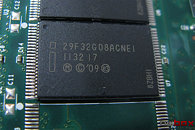Tuesday, April 3rd 2012

Intel SSD 313 "Hawley Creek" SSD Stripped Apart, Tested
With 3rd generation Core "Ivy Bridge" processors, and 7-series "Panther Point" chipset, Intel will also release a new line of cache-SSDs to complement its Smart Response Technology (SRT) feature, which provides a decent performance middle-ground between HDDs, and expensive SSDs. The SSD 313 "Hawley Creek" family will replace SSD 310 "Larson Creek" family. It consists of drives that make use of relatively low amounts of SLC NAND flash memory (which have much higher endurance than MLC NAND flash, making them ideal for caching). Built in the 2.5" SATA and mSATA form-factors, the drives will be available in two variants; the 20 GB variant offers 220/100 MB/s (reads/writes), with 36,000 4K random read IOPS, while the 24 GB variant offers 160/115 MB/s (reads/writes), with 33,000 4K random read IOPS.
HWBOX.gr got to test the SSD 313 20 GB variant on a current generation Z68 motherboard (ASUS Maximus IV Extreme-Z), and post its findings. The Greek tech-site tested its performance in what it's meant to do: SSD caching using Intel SRT. Findings show a healthy boost in performance, with synthetic benchmarks, including synthetic read/write performance, random-access (IOPS), PCMark, and real-world tests such as Windows 7 boot-time, and startup of content-creation applications, but the performance-difference between SRT and plain-HDD narrowed as tests with data-loads grew, which is expected. SSD caching merely places "hot-data" (frequently-accessed data of the HDD on the SSD, for quicker access), and shunts data in and out of the SSD, as "heat" of data on the HDD changes competitively. Find a ton of more test results at the source link.
Source:
HWBox.gr
HWBOX.gr got to test the SSD 313 20 GB variant on a current generation Z68 motherboard (ASUS Maximus IV Extreme-Z), and post its findings. The Greek tech-site tested its performance in what it's meant to do: SSD caching using Intel SRT. Findings show a healthy boost in performance, with synthetic benchmarks, including synthetic read/write performance, random-access (IOPS), PCMark, and real-world tests such as Windows 7 boot-time, and startup of content-creation applications, but the performance-difference between SRT and plain-HDD narrowed as tests with data-loads grew, which is expected. SSD caching merely places "hot-data" (frequently-accessed data of the HDD on the SSD, for quicker access), and shunts data in and out of the SSD, as "heat" of data on the HDD changes competitively. Find a ton of more test results at the source link.






1 Comment on Intel SSD 313 "Hawley Creek" SSD Stripped Apart, Tested